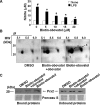Obovatol attenuates microglia-mediated neuroinflammation by modulating redox regulation
- PMID: 20397299
- PMCID: PMC2925488
- DOI: 10.1111/j.1476-5381.2010.00659.x
Obovatol attenuates microglia-mediated neuroinflammation by modulating redox regulation
Abstract
Background and purpose: Obovatol isolated from the medicinal herb Magnolia obovata exhibits a variety of biological activities. Here, the effect of obovatol and its mechanism of action on microglial activation, neuroinflammation and neurodegeneration were investigated.
Experimental approach: In microglial BV-2 cells stimulated with lipopolysaccharide (LPS), we measured nitric oxide (NO) and cytokine production, and activation of intracellular signalling pathways by reverse transcription-polymerase chain reaction and Western blots. Cell death was assayed in co-cultures of activated microglia (with bacterial LPS) and neurons and in LPS- induced neuroinflammation in mice in vivo.
Key results: Obovatol inhibited microglial NO production with an IC50 value of 10 mM. Obovatol also inhibited microglial expression of proinflammatory cytokines and inducible nitric-oxide synthase, which was accompanied by the inhibition of multiple signalling pathways such as nuclear factor kappa B, signal transducers and activators of transcription 1, and mitogen-activated protein kinases. In addition, obovatol protected cultured neurons from microglial toxicity and inhibited neuroinflammation in mice in vivo. One molecular target of obovatol in microglia was peroxiredoxin 2 (Prx2), identified by affinity chromatography and mass spectrometry. Obovatol enhanced the reactive oxygen species (ROS)-scavenging activity of Prx2 in vitro, thereby suppressing proinflammatory signalling pathways of microglia where ROS plays an important role.
Conclusions and implications: Obovatol is not only a useful chemical tool that can be used to investigate microglial signalling, but also a promising drug candidate against neuroinflammatory diseases. Furthermore, our results indicate that Prx2 is a novel drug target that can be exploited for the therapeutic modulation of neuroinflammatory signalling.
Figures












Similar articles
-
Chemical genetics of neuroinflammation: natural and synthetic compounds as microglial inhibitors.Inflammopharmacology. 2012 Jun;20(3):151-8. doi: 10.1007/s10787-011-0108-2. Epub 2011 Dec 22. Inflammopharmacology. 2012. PMID: 22189915 Review.
-
Obovatol attenuates LPS-induced memory impairments in mice via inhibition of NF-κB signaling pathway.Neurochem Int. 2012 Jan;60(1):68-77. doi: 10.1016/j.neuint.2011.11.005. Epub 2011 Nov 17. Neurochem Int. 2012. PMID: 22107706
-
Inhibitory effect of obovatol on nitric oxide production and activation of NF-kappaB/MAP kinases in lipopolysaccharide-treated RAW 264.7cells.Eur J Pharmacol. 2007 Feb 5;556(1-3):181-9. doi: 10.1016/j.ejphar.2006.10.054. Epub 2006 Oct 28. Eur J Pharmacol. 2007. PMID: 17134693
-
Anti-inflammatory and antioxidant mechanisms of urolithin B in activated microglia.Phytomedicine. 2019 Mar 1;55:50-57. doi: 10.1016/j.phymed.2018.06.032. Epub 2018 Jun 20. Phytomedicine. 2019. PMID: 30668443
-
Redox control of microglial function: molecular mechanisms and functional significance.Antioxid Redox Signal. 2014 Oct 20;21(12):1766-801. doi: 10.1089/ars.2013.5745. Epub 2014 May 5. Antioxid Redox Signal. 2014. PMID: 24597893 Free PMC article. Review.
Cited by
-
Chemical genetics of neuroinflammation: natural and synthetic compounds as microglial inhibitors.Inflammopharmacology. 2012 Jun;20(3):151-8. doi: 10.1007/s10787-011-0108-2. Epub 2011 Dec 22. Inflammopharmacology. 2012. PMID: 22189915 Review.
-
Lipocalin-2 Acts as a Neuroinflammatogen in Lipopolysaccharide-injected Mice.Exp Neurobiol. 2014 Jun;23(2):155-62. doi: 10.5607/en.2014.23.2.155. Epub 2014 Jun 13. Exp Neurobiol. 2014. PMID: 24963280 Free PMC article.
-
Flavonoids and Other Polyphenols: Bioactive Molecules from Traditional Medicine Recipes/Medicinal Plants and Their Potential for Phytopharmaceutical and Medical Application.Molecules. 2024 Dec 5;29(23):5760. doi: 10.3390/molecules29235760. Molecules. 2024. PMID: 39683916 Free PMC article. Review.
-
Interplays between inflammasomes and viruses, bacteria (pathogenic and probiotic), yeasts and parasites.Immunol Lett. 2020 Dec;228:1-14. doi: 10.1016/j.imlet.2020.09.004. Epub 2020 Sep 22. Immunol Lett. 2020. PMID: 32971149 Free PMC article. Review.
-
Aspirin-triggered lipoxin A4 attenuates LPS-induced pro-inflammatory responses by inhibiting activation of NF-κB and MAPKs in BV-2 microglial cells.J Neuroinflammation. 2011 Aug 10;8:95. doi: 10.1186/1742-2094-8-95. J Neuroinflammation. 2011. PMID: 21831303 Free PMC article.
References
-
- Araki W, Yuasa K, Takeda S, Shirotani K, Takahashi K, Tabira T. Overexpression of presenilin-2 enhances apoptotic death of cultured cortical neurons. Ann N Y Acad Sci. 2000;920:241–244. - PubMed
-
- Asehnoune K, Strassheim D, Mitra S, Kim JY, Abraham E. Involvement of reactive oxygen species in Toll-like receptor 4-dependent activation of NF-kappa B. J Immunol. 2004;172:2522–2529. - PubMed
-
- Bhat NR, Zhang P, Lee JC, Hogan EL. Extracellular signal-regulated kinase and p38 subgroups of mitogen-activated protein kinases regulate inducible nitric oxide synthase and tumor necrosis factor-alpha gene expression in endotoxin-stimulated primary glial cultures. J Neurosci. 1998;18:1633–1641. - PMC - PubMed
-
- Blasi E, Barluzzi R, Bocchini V, Mazzolla R, Bistoni F. Immortalization of murine microglial cells by a v-raf/v-myc carrying retrovirus. J Neuroimmunol. 1990;27:229–237. - PubMed
Publication types
MeSH terms
Substances
LinkOut - more resources
Full Text Sources
Molecular Biology Databases
Research Materials

